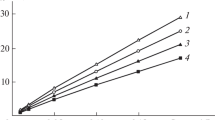Abstract
The electrical conductivity (EC) of ammonium heptamolybdate solutions in the concentration range 0.01–0.6 mol/L (based on Mo(IV)) is studied as a function of the reagent content in the solution and its temperature. The EC of the solution is shown to linearly increase with temperature. At a constant temperature of the solution, its EC increases nonlinearly as the ammonium heptamolybdate concentration increases. The linearization of the obtained temperature dependences of the EC makes it possible to calculate the temperature coefficients of the EC in the reagent concentration range under study and to determine the activation energy of the EC in the temperature range under study.





Similar content being viewed by others
REFERENCES
A. A. Palant and V. A. Bryukvin, “Electrochemical alternating current-assisted processing of metallic tungsten and molybdenum wastes in ammonia electrolytes,” Russ. Met. (Metally), No. 2, 171–173 (2004).
A. A. Palant and V. A. Pavlovskii, “Physicochemical and technological basics of electrochemical reprocessing of metallic tungsten wastes,” Technol. Met., No. 11, 3–7 (2003).
V. V. Shcherbakov, Z. Salem, V. I. Ermakov, and A. F. Vorob’ev, “Electrical conductivity and dielectric permittivity of aqueous ammonia solutions,” Elektrokhim., 28, 283–286 (1992).
V. V. Shcherbakov, Yu. M. Artemkina, T. N. Ponamareva, and A. D. Kirillov, “Electrical conductivity of the ammonia–water system,” Zh. Neorg. Khim. 54 (2), 321–323 (2009).
A Handbook on Electrochemistry, Ed. A. M. Sukhotin (Khimiya, Leningrad, 1981).
D. Dobos, Electrochemical Data: A Handbook for Electrochemists in Industry and Universities (Elsevier, Amsterdam, 1975).
O. M. Levchuk, A. M. Levin, and V. A. Bryukvin, “Effect of the tungsten(VI) and molybdenum(VI) ions on the electrical conductivity of ammonium hydroxide solutions,” Russ. Met (Metally), No. 3, 246–249 (2016).
O. M. Levchuk and A. M. Levin, “Effect of a DC magnetic field on the electrical conductivity of ammonia solutions containing tungsten(VI) and rhenium(VII) ions,” Russ. Met (Metally), No. 1, 22–25 (2015).
A. A. Palant and G. I. Anufrieva, “Electrical conductivity of ammonium hydroxide aqueous solutions containing tungsten and molybdenum ions,” Hydrometallurgy 42 (3), 435–439 (1996).
A. A. Palant, V. A. Bryukvin, and O. M. Gracheva, “Electrochemical alternating current-assisted reprocessing of metallic tungsten, molybdenum, and rhenium wastes in ammonia electrolytes,” Tsvet. Met., No. 11, 7 (2006).
V. M. Alkatseva, “Electrical conductivity of alkali solutions of sodium tungstate and molybdate,” Izv. Vyssh. Uchebn. Zaved., Ser. Tsvet. Met, No. 4, 28–31 (2005).
V. M. Alkatseva, “Electrical conductivity of ammonia solutions of ammonium molybdate,” in Proceedings of V International Conference on Sustainable Development of Mountainous Areas: Problems and Prospects of Integration of Science and Education (SKGMI, Vladikavkaz, 2004), рр. 288–290.
O. G. Kuznetsova, A. M. Levin, M. A. Sevost’yanov, O. I. Tsybin, and A. O. Bol’shikh, “Electrical conductivity of ammonia–alkali solutions and its activation energy,” Russ. Met. (Metally), No. 9, 921–925 (2019).
A. A. Afifi and S. P. Azen, Statistical Analysis: A Computer Oriented Approach (Academic Press, New York, 1975).
L. T. Vlaev and V. G. Georgieva, “Activation energy of the electrical conductivity of aqueous solutions of sulfuric acid, selenic acid, and potassium tellurate,” Elektrohim. 40 (6), 768–772 (2004).
A. N. Mashina, Yu. M. Artemkina, and V. V. Shcherbakov, “Temperature dependence of the activation energy of the electrical conductivity of aqueous solutions of strong electrolytes,” Usp. Khim. Khim. Tekhnol. 31 (4), 49–51 (2017).
E. A. Gorokhovskaya, I. A. Akimova, Yu. M. Artemkina, and V. V. Shcherbakov, “Peculiarities of determination of the activation energy of the electrical conductivity of electrolyte solutions,” Usp.Khim. Khim. Tekhnol. 33 (3), 92–94 (2019).
Funding
This work was performed in terms of state assignment no. 075-00746-19-00.
Author information
Authors and Affiliations
Corresponding author
Additional information
Translated by Yu. Ryzhkov
Rights and permissions
About this article
Cite this article
Kuznetsova, O.G., Levin, A.M., Sevost’yanov, M.A. et al. Electrical Conductivity of Ammonium Heptamolybdate Solutions and the Calculation of Its Activation Energy. Russ. Metall. 2021, 320–325 (2021). https://doi.org/10.1134/S0036029521030095
Received:
Revised:
Accepted:
Published:
Issue Date:
DOI: https://doi.org/10.1134/S0036029521030095




